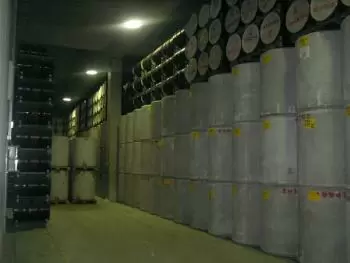
The nuclear industry generates radioactive waste that must be processed not to pose a risk to human health and harm to the environment.
Nuclear waste management works depending on its radioactive activity. In this way, they are distinguished:
-
Medium and low-level nuclear waste.
-
High-level nuclear waste.
Low and medium-level waste storage
Low and medium-level nuclear waste is stored using natural and artificial barriers. In this way, nuclear waste is isolated from the environment until its radioactivity falls to harmless levels.
This type of waste is transported and stored in facilities prepared for it. Most are cleaning cloths, filters, impurities in circuits, ion exchange resins, parts of installations, etc., from nuclear power plants.
This group also includes gloves, syringes, containers, needles, biological waste, etc., generated in hospitals and industries with low or medium radioactivity.
How are the disposal facilities to store this type of radioactive waste?
A typical waste repository consists of the following buildings and structures:
-
Low and medium-level waste conditioning building: where compaction, incineration, etc., are carried out.
-
Structures for storing said waste: cells aligned in two esplanades and in a double row where the properly conditioned waste will be placed.
-
Quality verification laboratory: The characterization processes, verification tests, and control of the characteristics of the radioactive packages received or conditioned at the facility are carried out, and research activities are carried out.
-
Service and control buildings.
The arrival of radioactive material
The waste to be stored arrives in 220-liter drums transported by trucks enabled for this type of transport. The drums are unloaded in the temporary reception building before the conditioning building.
On this site, drums are identified and classified into various categories. Subsequently, the drums are introduced into the containers. Once the lid has been placed in the containers, the mortar is injected to immobilize its content. Each of these containers weighs 24 tons.
Storage
As the last step in the process, these concrete containers are placed inside the nuclear waste storage cells. Once each cell is filled, it is closed with a concrete plate that is subsequently waterproofed.
Once completed, the cells will be lined with alternate layers of draining and impermeable materials. These layers prevent rainwater leaks from coming into contact with the radioactive elements and keeping the geological formations as they were.
The infiltration control network has sampling points for measuring radioactivity. This network also has a water collection tank. These tanks concentrate all the pipes of the nuclear waste storage cells to be controlled and treated if any indication of contamination is found.
International strategies and systems for the storage of low and medium level waste
For some years, low-level waste storage was carried out by dumping into the sea. Today, this practice is totally prohibited in most laws.
The currently valid solution for the storage of waste from nuclear energy is permanent storage on land. There are two options:
-
Surface storage with engineered barriers. This type of storage aims to prevent surface or underground water from coming into contact with the cement drums. Both during the storage phase and afterward, monitoring of the installation is necessary.
-
Underground storage at low or medium depth. Mines or artificial underground galleries are used. When the storage gallery is complete, the entrance tunnels are sealed with bentonite. When all storage is whole, they are locked to the surface to prevent the possibility of access. Sealed storage does not need any surveillance.
High-level waste
High-level wastes are wastes that emit long-lived alpha particles, beta particles, or gamma rays (or a combination of them) with half-lives of more than 30 years.
This type of nuclear waste contains radioactive isotopes with half-lives of more than 30 years. In addition, they can emit heat and be active for thousands or tens of thousands of years.
Generally, high-level waste comes from spent nuclear fuel from nuclear reactors at nuclear power plants. The waste produced comes from fuel assemblies of this energy source.
Stages of high-level waste management
The management of high-level nuclear waste is carried out in different stages:
-
Initial storage. Spent fuel from a nuclear power plant is stored for a few years in the spent fuel pools of nuclear power plants. The purpose is to reduce the heat load.
-
Intermediate storage. It is stored in the medium or long term (between 20 and 60 years) in spent fuel pools, in dry containers, or in individualized temporary warehouses (the plants that have it). It can also be stored in a centralized temporary warehouse outside the nuclear plant. It is held in dry casks that is a method of storing high-level radioactive waste. Barrels are typically steel cylinders that are either welded or bolted closed.
-
Permanent disposal. Given the long period of activity of these wastes, deep geological storage is the internationally accepted option for the final management of high-level radioactive waste.
Fuel reprocessing
Other countries adopt closed-loop strategies to reduce the volume of this waste and reuse fissile materials, such as reprocessing spent fuel. This technique involves the separation of the uranium and plutonium contained in the fuel. The product obtained is used again in another nuclear fission process in nuclear power plants.